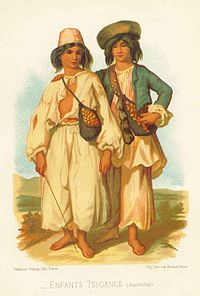
The Romani, also spelled Romany or Rromani and colloquially known as the Roma, are an ethnic group of Indo-Aryan origin who traditionally lived a nomadic, itinerant lifestyle. Linguistic and genetic evidence suggests that the Romani originated in the Indian subcontinent, in particular the region of present-day Rajasthan. Their subsequent westward migration, possibly in waves, is now believed by historians to have occurred around 1000 CE. Their original name is from the Sanskrit word डोम, doma and means a member of the Dom caste of travelling musicians and dancers. The Roma population moved west into the Persian Ghaznavid Empire and later into the Byzantine Empire. The Roma are thought to have arrived in Europe around the 13th to 14th century. Although they are widely dispersed, their most concentrated populations are located in Bulgaria, Hungary, Romania, Spain, and Turkey.

The Sinti are a subgroup of Romani people. They are found mostly in Germany, France and Italy and Central Europe, numbering some 200,000 people. They were traditionally itinerant, but today only a small percentage of Sinti remain unsettled. In earlier times, they frequently lived on the outskirts of communities.
The Romani people have long been a part of the collective mythology of the West, where they were depicted as outsiders, aliens, and a threat. For centuries they were enslaved in Eastern Europe and hunted in Western Europe: the Pořajmos, Hitler's attempt at genocide, was one violent link in a chain of persecution that encompassed countries generally considered more tolerant of minorities, such as the United Kingdom. Even today, while there is a surge of Romani self-identification and pride, restrictive measures are being debated and passed by democratic states to curb the rights of the Romani people.

The Museum of Romani Culture is an institution dedicated to the history and culture of the Romani people (Gypsies). It is situated in Brno, Czech Republic.
The Romani in Spain, generally known by the endonym Calé, or the exonym gitanos, belong to the Iberian Romani subgroup known as Calé, with smaller populations in Portugal and in Southern France. Their sense of identity and cohesion stems from their shared value system, expressed among gitanos as las leyes gitanas.

Romani people in Bulgaria constitute Europe's densest Roma minority. The Romani people in Bulgaria may speak Bulgarian, Turkish or Romani, depending on the region.

Romani people are an ethnic minority in the Czech Republic, currently making up 2–3% of the population. Originally migrants from North Western India sometime between the 6th and 11th centuries, they have long had a presence in the region. Since the creation of Czechoslovakia in 1918, the Romani population have experienced considerable hardship, having been a main target of Nazi extermination programs during World War II, and the subject of forced relocation, sterilisation, and other radical social policies during the Communist era. In the successor state, the Czech Republic, challenges remain for the Romani population with respect to education and poverty, and there are frequent tensions with the white majority population over issues including crime and integration.
The presence of a Romani minority in Ukraine was first documented in the early 15th century. The Romani maintained their social organizations and folkways, shunning non-Romani contacts, education and values, often as a reaction to anti-Romani attitudes and persecution. They adopted the language and faith of the dominant society, being Orthodox in most of Ukraine, Catholic in Western Ukraine and Zakarpattia Oblast, and Muslim in Crimea.
The number of Romani people in Ireland is roughly estimated, as the Central Statistics Office collects its data based on nationality and not ethnic origin. For this reason a precise demographic profile of the Romani in Ireland is not available. Some estimates of Romani in Ireland give the population at 1,700 in 2004, rising to between 2,500 and 3,000 in 2005. The majority derived from Romani populations originating in Ukraine and Hungary.
The Romani people of Greece, or Romá, are called Tsinganoi, Athinganoi (Αθίγγανοι), or the more derogatory term Gyftoi. On 8 April 2019, the Greek government stated that the number of Greek Roma citizens in Greece is around 110,000. Other estimates have placed the number of Romani people resident in Greece as high as 350,000.
The Romani people in Turkey or Turks of Romani background are Turkish citizens and the biggest subgroup of the Turkish Roma. They are Sunni Muslims mostly of Sufi orientation, who speak Turkish as their first language, in their own accent, and have adopted Turkish culture. Many have denied their Romani background over the centuries in order to establish a Turkish identity, to become more accepted by the host population. They identify themselves as Turks of Oghuz ancestry. More specifically, some have claimed to be members of the Yörüks, Amuca, Gajal or Tahtacı.
Romani people in France, generally known in spoken French as gitans, tsiganes or manouches, are an ethnic group that originated in Northern India. The exact number of Romani people in France is unknown; estimates vary from 500,000 to 1,200,000.
According to the last census from 2021, there were 67,179 persons counted as Romani people in Slovakia, or 1.23% of the population. However, the number of Roma is usually underreported, with estimates placing the Roma population at 7-11% of the population. Thus the actual number of Roma may be over half a million.

Romani people in North Macedonia are one of the constitutional peoples of the country.

There have been Romani people in Croatia for more than 600 years and they are concentrated mostly in the northern regions of the country.
Sinte Romani is the variety of Romani spoken by the Sinti people in Germany, France, Austria, Belgium, the Netherlands, some parts of Northern Italy and other adjacent regions. Sinte Romani is characterized by significant German influence and is not mutually intelligible with other forms of Romani. The language is written in the Latin script.

Romani Americans are Americans who have full or partial Romani ancestry. It is estimated that there are one million Romani people in the United States. Though the Romani population in the United States has largely assimilated into American society, the largest concentrations are in Southern California, the Pacific Northwest, Southwestern United States, Texas, Louisiana, Florida and the Northeast as well as in cities such as Chicago and St. Louis.
The Romani people in Canada are citizens of Canada who are of Romani descent. According to the 2021 Canadian census there were 6,545 Canadians who claimed Romani ancestry. They are sometimes referred as "gypsies", but that is considered to be a racial slur.

Romani people in Germany are estimated to around 170,000-300,000, constituting around 0.2-0.4% of the population. One-third of Germany Romani belong to the Sinti group. Most speak German or Sinte Romani.
Albania houses a large population of Romani, who are part of the larger Romani diaspora.










